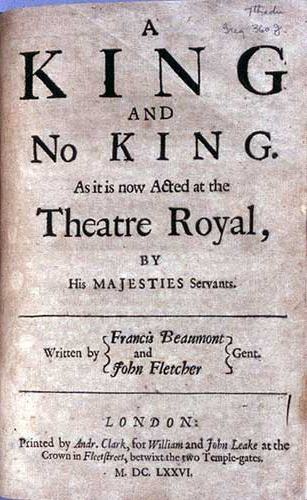Related Research Articles

James Shirley was an English dramatist.
The Platonick Lovers is a Caroline era stage play which blends the genres of tragicomedy, satire, and comedy of manners. It was written by Sir William Davenant and first printed in 1636. The play can be regarded as one of the more subtle and successful satires in the English language: Davenant managed to ridicule the obsession of his employer without losing his job.
Queen Henrietta's Men was an important playing company or troupe of actors in Caroline era in London. At their peak of popularity, Queen Henrietta's Men were the second leading troupe of the day, after only the King's Men.
The Wedding is a Caroline era stage play, a comedy written by James Shirley. Published in 1629, it was the first of Shirley's plays to appear in print. An early comedy of manners, it is set in the fashionable world of genteel London society in Shirley's day.
The Night Walker, or The Little Thief is an early seventeenth-century stage play, a comedy written by John Fletcher and later revised by his younger contemporary James Shirley. It was first published in 1640.
The Coronation is a Caroline era stage play, a tragicomedy written by James Shirley, and notable for the tug-of-war of authorship claims in which it was involved in the middle seventeenth century.
Love Tricks, or The School of Complement is a Caroline stage play by James Shirley, his earliest known work.
The Ball is a Caroline comedy by James Shirley, first performed in 1632 and first published in 1639.
The Sun's Darling is a masque, or masque-like play, written by John Ford and Thomas Dekker, and first published in 1656.
Hyde Park is a Caroline era comedy of manners written by James Shirley, and first published in 1637.
The Young Admiral is a Caroline era tragicomedy written by James Shirley, and first published in 1637. It has often been considered Shirley's best tragicomedy, and one of his best plays.

The Gamester is a Caroline era stage play, a comedy of manners written by James Shirley, premiered in 1633 and first published in 1637. The play is noteworthy for its realistic and detailed picture of gambling in its era.
The Witty Fair One is a Caroline era stage play, an early comedy by James Shirley. Critics have cited the play as indicative of the evolution of English comic drama from the humors comedy of Ben Jonson to the Restoration comedy of Wycherley and Congreve, and the comedy of manners that followed.
Love's Sacrifice is a Caroline era stage play, a tragedy written by John Ford, and first published in 1633. It is one of Ford's three surviving solo tragedies, the others being The Broken Heart and 'Tis Pity She's a Whore.
The Fancies Chaste and Noble is a Caroline era stage play, a comedy written by John Ford, and notable for its treatment of the then-fashionable topic of Platonic love.
The Lady's Trial or The Ladies Triall;is a Caroline era stage play, a comedy by John Ford. Published in 1639, it was the last of Ford's plays to appear in print, and apparently the final work of Ford's dramatic career. A copy of the play can be found in the Henry E. Huntington Library and Art Gallery under the name The Ladies Triall.
The Changes, or Love in a Maze is a Caroline era stage play, a comedy of manners written by James Shirley, first published in 1639. It was one of Shirley's most popular comedies, especially in the Restoration era. The play is almost universally known by its subtitle.
The Example is a Caroline era stage play, a comedy written by James Shirley, first published in 1637. The play has repeatedly been acclaimed both as one of Shirley's best comedies and one of the best works of its generation. And it provides one of the clearest demonstrations in Shirley's canon of the influence of the works of Ben Jonson on the younger dramatist's output.
The Duke's Mistress is a Caroline era stage play, a tragicomedy written by James Shirley and first published in 1638. It was the last of Shirley's plays produced before the major break in his career: with the closing of the London theatres due to bubonic plague in May 1636, Shirley left England for Ireland, where he worked under John Ogilby at the Werburgh Street Theatre in Dublin for four years.

A King and No King is a Jacobean era stage play, a tragicomedy written by Francis Beaumont and John Fletcher and first published in 1619. It has traditionally been among the most highly praised and popular works in the canon of Fletcher and his collaborators.
References
- ↑ David Moore Bergeron, Textual Patronage in English Drama, 1570–1640, London, Ashgate, 2006; p. 202.
- ↑ Chamber's Cyclopaedia of English Literature, 1902; p. 485.
- ↑ Terence P. Logan and Denzell S. Smith, eds., The Later Jacobean and Caroline Dramatists: A Survey and Bibliography of Recent Studies in English Renaissance Drama, Lincoln, NE, University of Nebraska Press, 1978; p. 155.
- ↑ Richard Levin, The Multiple Plot in English Renaissance Drama. Chicago, University of Chicago Press, 1971; pp. 96-101.
- ↑ Levin, p. 99.